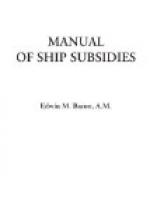The results of the investigation were embodied in an elaborate report, comprising majority and minority reports of the commission, and the mass of testimony taken at the hearings: the whole filling three large pamphlet volumes, in all of nearly two thousand pages.[HS]
The majority reported a bill. This was presented as merely an extension of the principles of the Postal Aid Act of 1891, involving “no new departure from the established practice of the Government.” Its ocean mail sections were intended “simply to strengthen the existing act on lines where it has happened to prove inadequate.” The subsidies which it granted were termed, inoffensively, “subventions,” and its promoters protested that these “subventions” were “not in any opprobrious sense a subsidy or bounty.” They were “not bounties outright, or mere commercial subsidies such as many of our contemporaries give.” They were “granted frankly in compensation for public services rendered and to be rendered."[HT]
The proposed measure, however, was more than an extension of the act of 1891. Its scope was indicated by its title: “To promote the national defence, to create a force of naval volunteers, to establish American ocean mail lines to foreign markets, to promote commerce, and to provide revenue from tonnage.” The subsidies offered comprised mail subventions to steamships; subventions to general cargo carriers and deep-sea fishing-ships, both steam and sail; and retainers to officers and men of American merchant ships and deep-sea fishing vessels enrolling as naval volunteers. It opened with provisions for the establishment of a naval reserve.




